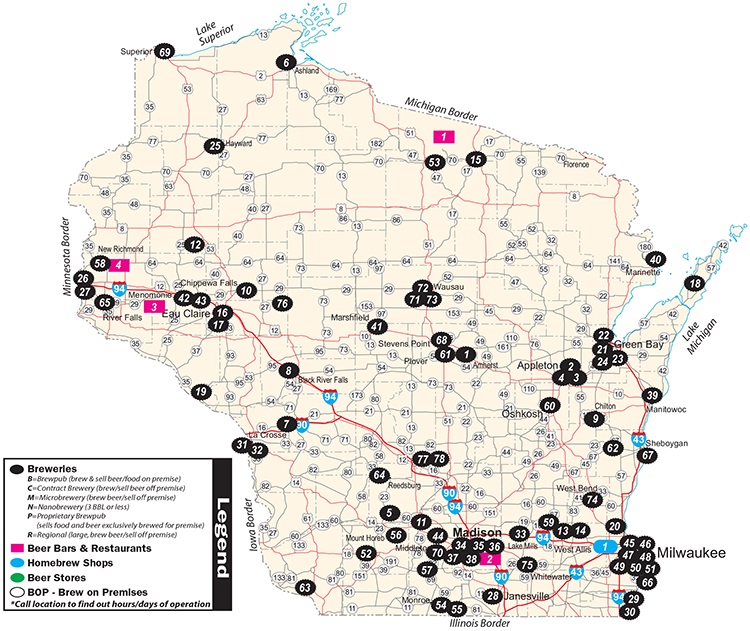I’m from Wisconsin. Perhaps, then, it is unsurprising that I like to brew.
Brewing is something that is innate to most of us who are deeply engaged in Magic, whether we’re good at it or not. I know this might sound like regional snobbery, but I have evidence. Witness the following:
As you can see, there is a lot of brewing going on in Wisconsin, and, unsurprisingly a lot to be found in Madison. Madison’s brewers include people like me, Sam Black, Brian Kowal, and many others. Milwaukee ain’t too shabby, either; Owen Turtenwald has been known to make a good brew now and again.
Wizards of the Coast is giving Wisconsin a big nod this year, with a Pro Tour in Milwaukee and a Grand Prix in Madison on the horizon. I’d like to think it is, at least in part, because of the brewers.
All kidding aside, understanding how to find a good brew is a very important thing for a would-be Magic player. It isn’t necessary that every person who wants to do well at competitive Magic be a decent brewer, but it is probably good to have at least one decent brewer in your Magic crew. It’s hard to play this game completely solo, and having people you work with is a way to split up the effort in this difficult game. Being a Lone Wolf can work now and again, but it isn’t usually sustainable; this game is just bigger than all of us.
The process of brewing is an ongoing one. Usually, what you make will not be successful. That is just part of the process though. Getting better at that process is one of the best ways to discover great decks more often. Practicing this skill can reap huge rewards. There are few things more rewarding than finding that brew, taking it to a tournament, and winning.
If you’ve had that feeling, you know just how incomparable it is; if you haven’t but you want to, this article will help you potentially find out what it is like.
Dragons of Tarkir is here. So let’s start brewing! I’m not going to say that this is the only way to go about brewing, but I’ve had a lot of success with this method.
1 – Make it Small (Micro-Small)
Artists and writers will tell you that for most of them the hardest thing to do is to create in a pure vacuum. “Do art!”, “Write!”, and “Brew a Deck!” all have a lot of things in common. Putting something new into the world usually works best when you have limitations.
Imagine sitting down without them. “Brew a Deck!” is actually a nearly insurmountable task. As a whole, you’re talking about a near-infinite variety of format and card combinations. If we make up a miniature version of Commander, with only 1,000 legal cards, with 100 card decks (and no Commander), we’re talking ~6.4 x 10^139 possible combinations! That is 640000000000000000000000000000000000000000000000000000000000000000000000000000000
00000000000000000000000000000000000000000000000000000000000
(or 6.4 x 10^39 times larger than a googol – my apologies if my math is slightly off).
Now, obviously some of those potential “decks” would be incoherent messes that simply wouldn’t function. This isn’t taking into account, for example, needs like mana and having spells that make sense together.
Even that concept, “spells that makes sense together,” though, is in the eye of the beholder. One of my very first Magic decks was a W/G “Anti-Magic” deck that I thought was very powerful. It was about a hundred or so cards big, and didn’t really have a coherent format you could associate with it. I’d won a ton of group games with it, and the deck, in my own mind, had a ton of combos. Take, for example, this epic combo:
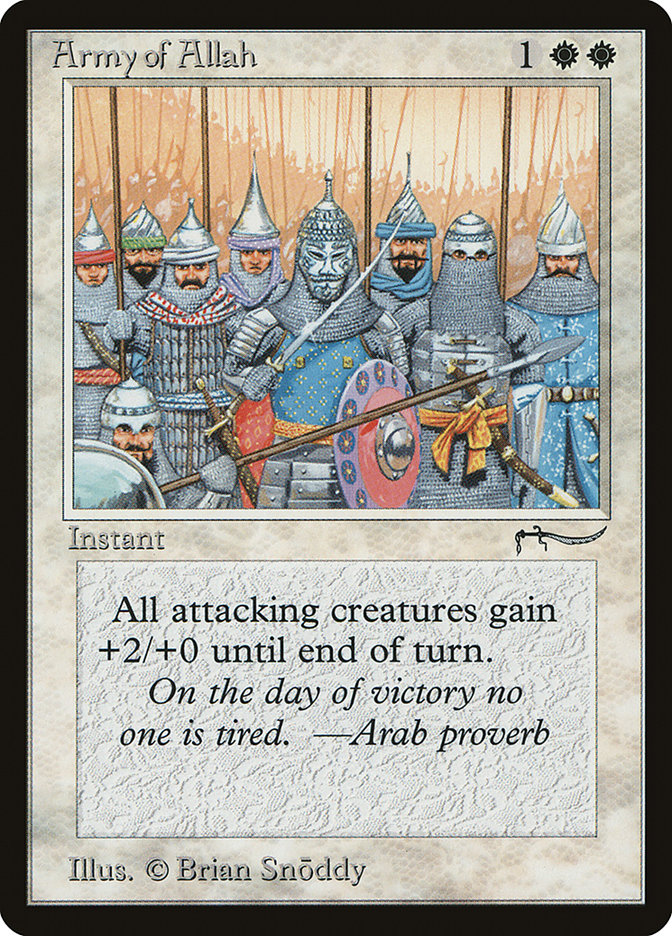
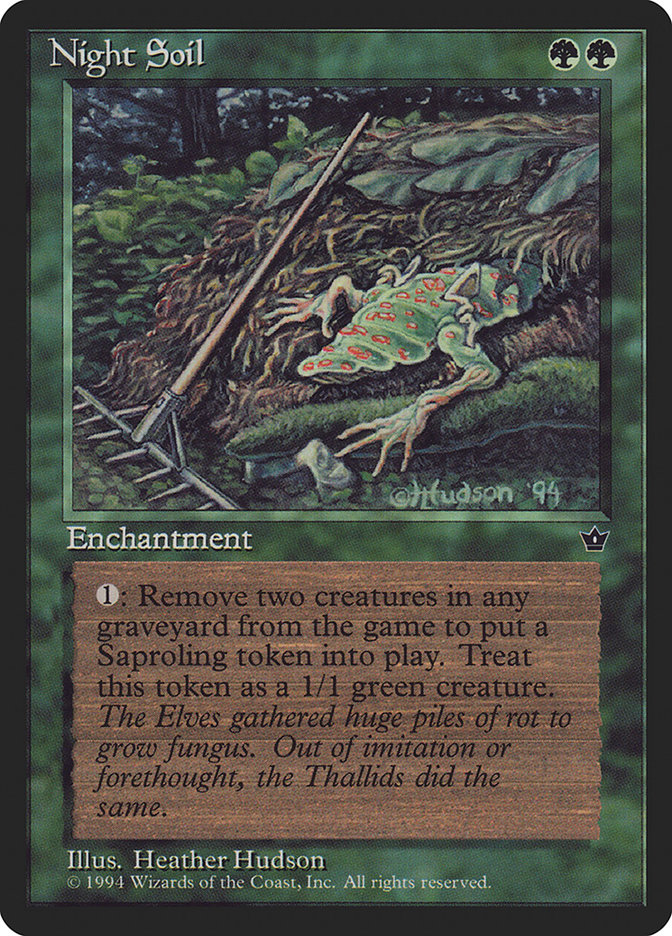
In the small world that was my game store and the friends at my school, my deck was competitive. Outside of that world, though, I was in for a rude awakening.
Now, perhaps someday, someone could make a simulator that could take every possible combination of cards for a format (including the clearly unplayable ones), have a supercomputer jam them all against each other, and output a “best deck.” Conceptually, this is actually something in the realm of possibility. However, in the world where we don’t personally have access to this, we have to begin somewhere. I think the best place to start is to start small.
Now, with the above deck I mentioned, with Army of Allah and Night Soil, in its own little world, the idea was to make a deck that would have a bunch of reasonable creatures, and would make life difficult for more complicated decks by having access to a lot of cards akin to Disenchant. This deck started out with the idea that it was an “anti-Magic” deck. For the environment it was in, a casual-but-we-don’t-know-it group of Spikes, generally playing group games, this was a fine starting place.
At the time, I didn’t know what formats were. This is the first limitation to make on yourself. From there, go smaller yet.
An overall concept can be a reasonable next step. “I’d like to make a Burn Deck” or “I want to make an R/G deck that attacks.” However, I like to go even smaller, by focusing on a mechanic, a two-card mini-combo (like Domri Rade and Courser of Kruphix), or even a single card.
2 – Consider the Incentives
So, you could be working on discovering anything under the Magic sun. Why are you working on this specific concept rather than another? How will you get paid off by what you’re working on?
If you can’t think of anything at all, your work is done. You can come back to the idea another time, but start again with a new micro-small starting place. If there isn’t a reward for pursuing an idea, there are plenty of other ideas in the sea. “It’s cool,” may be a fun concept, but if you’re Spikey, you should recognize that this is the beginning of a trap.
The incentives can be anything as large as positioning in a metagame or as small as being able to play a different card. Here are some examples:
- Now that there are a lot of reliable mana accelerants, I can play this expensive, powerful spell (e.g., Hornet Queen, Karn Liberated).
- Now that there are a threshold of cards of a certain class, a new strategy is available (e.g., Burn, Affinity, Merfolk).
- This other powerful card existed, but it was too difficult to use; now maybe you can (e.g., Emrakul, Glimpse of Nature, Worldgorger Dragon).
- This card makes an already-powerful card even better (countless examples).
- A lot of decks could be susceptible to what this deck does by its very nature (e.g., Death and Taxes, Burn, Prison).
- A card combo creates an engine that just needs to be exploited (e.g., Seismic Swans, Pyromancer Ascension, Necropotence/Donate).
When you’re determining the incentives of a deck, they don’t need to be world shattering. They just need to simply exist. Some great brews come out of small ideas as someone discovers, bit-by-bit, a deck that works.
I’ve long-been of the opinion that we don’t make decks, but rather, we discover them. A part of why I feel this way is that the cards themselves pre-exist. Before we ever make a deck, it’s probably that Erik Lauer and company were already there, world-building that deck for us. Only after these Gods of Magic create our universe are we are let loose in it, free to try to climb those mountains or descend into incredible ravines. If we find something incredible, maybe, like explorers, we can have people name it after us, or have poets and bards sing songs about us, but the raw material that made that deck was there long before we got there. Who created Goblins, for example? I’d be hard pressed to say (and would be pretty dubious of anyone who claimed to know). However, who discovered Sligh, the classic Red Aggro deck that introduced the concept of the mana curve? Well, that would be Jay Schneider, unquestionably.
The beginning of this discovery process involves seeing that distant peak, or looking out at the horizon of the frontier, and having a reason to go there.
3 – Lists, Look at Them and Make Them
Brainstorming is a huge element in the process of brewing. One of the things that I find most important is to go over all of the cards that are worthy of consideration, again and again.
At an Open Series event a long time ago, I spoke a little with Reid Duke about his own process, and it sounded a lot like mine. He would go through lists electronically (either in Gatherer or on Magic Online), scouring all of the legal cards, no matter how horrible, to see if they fit into the concept that he was thinking about. I do the same thing, but I actually prefer to do it with a physical piece of paper.
A part of my reason for doing this has a lot to do with the field of cognition studies. One account in Scientific American does a good job of summing up all of this, but most people simply do better at retaining knowledge from physical copies. The added benefit of physical copies is the ease of making notations.
I maintain a current .doc file of Standard, alphabetized by category (land, colorless, WUBRG colors, gold by wedge/guild/shard), with noteworthy cards highlighted so they stick out more. I can always search it electronically with the ol’ Control-F feature, but I generally prefer to do things this way because of the small accidents of browsing that can happen. For example, if you’re looking for cards to go in your Annex/Wildfire deck, accidentally stumbling on Icy Manipulator can be a big deal.
In addition, though, I’ve had terrible luck with all of the current search options out there. Whether it is a website, Gatherer, or Magic Online, I’ve done searches for cards that I know exist, and inexplicably they sometimes don’t show up. Later, when I find the card, I’m mystified that it didn’t show up in a search for, say, Birds that are white. In Modern or Legacy, the physical list for something like this is simply too large to actually maintain, and so I go back to relying on electronic sources, but for smaller formats, I greatly prefer paper.
In this stage of the process, as you look through a list of cards, you should be keeping your mind as open as possible. Write down all of the cards that might fit into the concept. Try to exercise some degree of restraint, but err on the side of “too open-minded;” if a card isn’t worthy of the final cut for a deck, it won’t hurt to have considered it.
4 – Play with the Idea
After you’ve compiled a list of cards, look for the cards that seem the most powerful and imagine them in play with each other. Right now, you aren’t trying to hammer out a perfect sixty-card deck. Rather, what you’re doing is you’re gathering together all of these cards you’ve listed and looking for a way to make them act in concert.
Decks are not collections of atomized cards, they are cards existing in relationship with both each other and an ecology that represents the current metagame. Even in a semi-unknown metagame that exists shortly after a format is first revealed and unleashed, the ecology of those cards exists.
Shortly after Fate Reforged came out, there was a minor explosion in W/B Warriors decks. A large part of this is the way in which some of the new Fate Reforged cards like Mardu Strike Leader and Battle Brawler both worked in concert with aggressive black and white cards from Khans of Tarkir like Chief of the Edge and Bloodsoaked Champion. While very little of significance came out of this archetype, it was indeed promising, in large part because of the ways in which each constituent part seemed to be a cog in a greater machine.
Look for that greater machine in your constituent parts. Ultimately, you hope a deck will be greater than the sum of its parts. A successful deck will do something special, so see if you can find it somehow in the combination of cards you’ve listed. If you’ve done this a lot, or if you’re a student of history, you might notice the important things that stick out.
5 – Think About History
This is an area where I’ve certainly gotten a fair amount of criticism. For many people, the past is a seemingly-unimportant part of the game because the newest format invalidates the previous format to some degree, let alone far older formats. To some degree, I have sympathy for this point of view. Magic doesn’t care how you did yesterday, it is always changing and living in the past won’t get you anywhere.
That is very different, however, than taking lessons from the past.
History can tell us a lot. It can tell us, for example, that red aggressive decks rarely do well if they are taking a lot of damage from their lands. It can tell us, for example, what a stable manabase looks like for a similar archetype. It can give us clues as to the variety of mana curves that can work for different decks of different strategic archetypes. They can provide us with information about how strategic archetypes can succeed in interacting with each other.
Towards the very end of the moment in last year’s Standard when Bant, featuring Thragtusk and Sphinx’s Revelation, was the dominating deck, I made a four-color brew that felt very promising. It was a WURB Control deck, and if I’d had more time to play it, I think it might have done very well for me. Jackie Lee was able to make money with the deck, and people didn’t understand how it was possible that the mana could work out. It was simple: I took Reid Duke’s Bant list as a base, and I made sure I had at least as much mana for each of my colors as he did in each of his. I knew that Reid’s deck was successful, and so I did some modeling of the elements of his deck that I could copy.
Mana is a particularly easy thing to do this with. Being able to cast your spells is something that doesn’t change much in time, now that Wizards has decided to nix aggressive land destruction (RIP, Ponza and friends). I know, for example, in an aggressive deck that runs cards like Ash Zealot or Bassara Tower Archer, if I want to get two colored mana of a specific color on turn two, I’d better be running at least seventeen sources if I want it to be consistent. If I’m trying to hit something like UUU or RRR, I’d better have twenty-one; you can get there with twenty, but you will stumble on it often enough that it will affect games. When you’re making that balance in your deckbuilding, you might just accept that outcome based on all manner of factors, but it is important to know.
When you’re working on whatever deck you have in front of you right now, make sure to think about the past. If you recall an idea that is somehow similar to what you’re working on, look it up. It is possible that it will spur new ideas that are legal now, even if the deck you’re looking at is over ten years old. It is possible that it will even give you clues as to what is simply not effective, especially if you become a true student of Magic history.
To mix metaphors, don’t force yourself to reinvent the wheel when you could choose to stand on the shoulders of those who come before you (some of whom may be giants).
6 – Accept Change
As you’re going through and making a list of cards, imagining how they will fit together with wherever you started this journey, something else may begin to happen. As you walk towards the mountains, you might notice something even more compelling. Don’t be afraid to change directions.
Decks can drift. Sometimes they only drift a little, and sometimes they drift a lot. Go with it.
There are some concepts that are so powerful that they almost have their own gravity. One of the examples of this that I often think of is during the Standard seasons when Psychatog and Faeries were dominating. If you were building decks during these two times (Odyssey-era Standard and Lorwyn-era Standard, respectively), it ended up being incredibly difficult to not end up being some version of these two decks if you were trying to be a deck with counterspells. Simply put, as you go through your options step-by-step, the better option ends up being a known quantity.
It is in this way that deck drift can take you right up to those massive objects in the solar system, the juggernauts of the current format. If your brew drifts into something already known, there is nothing wrong with that. The decks that have the gravity of something like Jupiter are like that because they are huge and powerful. If you’re really looking to brew something new, you can start over, but it won’t do you any good to aggressively resist deck drift and simply become a lesser, weaker version of a pre-existing archetype.
There are less dramatic drifts that can happen, though. You might begin by working on a midrange deck that is exploiting the card you wanted to work on in step one, when you were focusing on a single card or mechanic. By the end of your process, though, you might not even be using that card or any card with that mechanic!
This is not a failure.
Arriving at a good destination can sometimes be the result of chance. Earlier, I alluded to my old deck Eminent Domain. This deck is one of my favorite decks that I’ve built of all time, and is a deck that people still bring up to me as one of their favorites. (CEDitor’s Note: The amount of class I skipped to play this deck on Magic Online is truly frightening. Easily my favorite Adrian deck of all time.) I won the Wisconsin State Championships with it, and several of my crew played it that day in various events throughout the country. It ended up being arguably the most successful deck of the day. If you’re unfamiliar with the list, here it is:
Creatures (6)
Lands (23)
Spells (31)
Sideboard

The key element of the deck was the combination of these two cards:
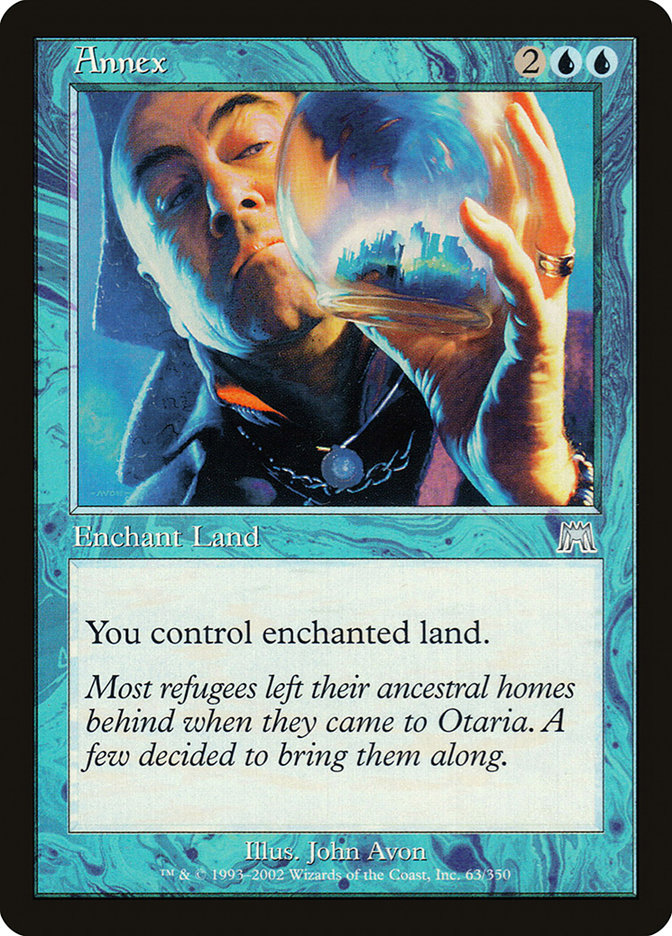

When I first started brewing this deck, I was trying to recreate Ponza, the Mono-Red land destruction deck that I’d had a lot of success with. Ultimately, after both looking at the cards and after playing a very small handful of games (less than five), I realized that the deck didn’t work. But, going through a list of cards, I saw Annex. Immediately, the vision of Annex into Wildfire crept into my imagination. From there, I thought about Signet into Annex, and the picture was complete.
If I had doggedly continued onward trying to make Ponza, I never would have discovered this deck, one of my all-time favorites. However, I wasn’t tied to that initial concept. I was open to wherever the journey took me, and I was rewarded for it.
7 – Test It
There is no substitute for actually seeing how it plays out.
The work of playtesting itself could fill up chapters in a book, so I’ll leave that for another day, but simply put, try to see if the idea works.
Playing a solitaire game with no one but your goldfish as an opponent is a good way to start. Does the mana work out? Does it feel like an actual deck? Does it look like it is doing powerful things?
Especially for a combo deck, this can be an easy thing to look at. It is actually much harder to do with an interactive deck like a control deck. However, this initial stage can be one where you can see it is time to go back a few steps and do more thinking.
Having an actual opponent can hammer out all manner of details. Most often, the conclusion will be that this deck isn’t ready for the prime time. But what you can do is see what lessons can be gleaned. Perhaps you’ll learn, for example, that while it was bad before, now Fate Unraveler is a good card. Perhaps you’ll learn that the new card you’re trying out is fantastic against Tarmogoyf decks, but that the rest of the deck isn’t cohesive.
Most creations are competitive failures. However, the lessons you learn can be a great opportunity to strive again, from the beginning with a new micro-small beginning.
Let’s overview.
1 – Make it Small (Micro-Small)
2 – Consider the Incentives
3 – Lists, Look at Them and Make Them
4 – Play with the Idea
5 – Think About History
6 – Accept Change
7 – Test It
Now, let’s give it a try, by way of example. This isn’t a deck I’m working on for the upcoming Pro Tour, but I think it shows how the process works quite well.
So, I play against an opponent online who is playing Mastery of the Unseen, a card I quite like. Idly, it reminds me of Heliod, God of the Sun, and I wonder if there is any home for a Heliod deck out there. It is quite similar to Mastery of the Unseen, but it has a different collection of upsides.

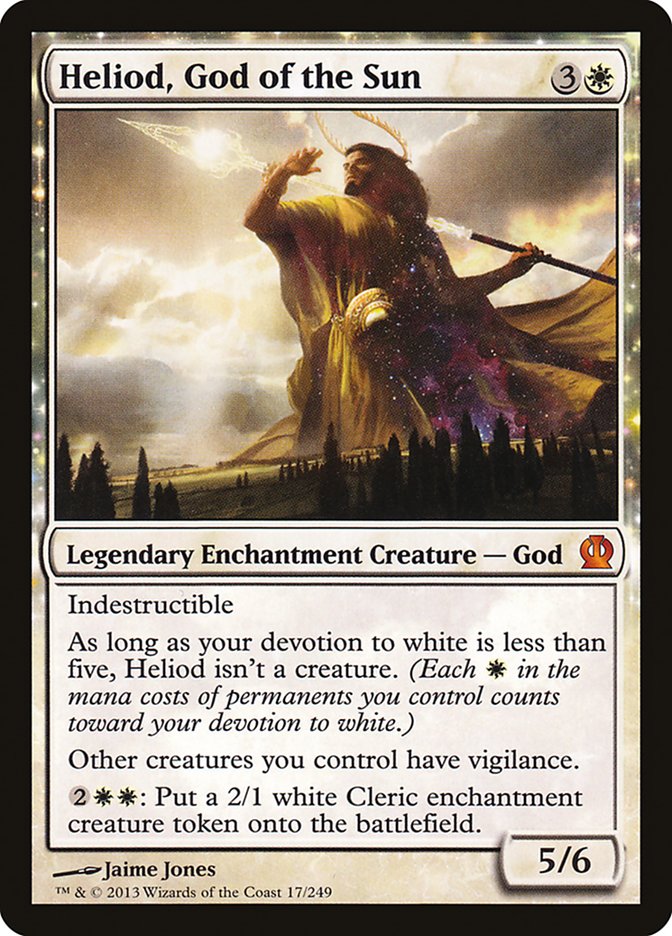
While more expensive than Mastery of the Unseen, I do like that Heliod can potentially be an attacker itself if sufficient devotion is present. 5/6 is not a small body, and it is possible to substantiate it just by casting your spells. In an aggressive deck, this sounds appealing, and even though four mana is a lot to create a two-power creature, there is some evidence that this is worth pursuing.
So, imagining that this is a white devotion-inspired list, looking through the potential cards to consider is much easier: I can focus on white cards only, and try to make as many white mana symbols as possible appear on the card. In addition, this will be a list that is more likely to rely on permanents, though other cards might spring up. I make the following list:
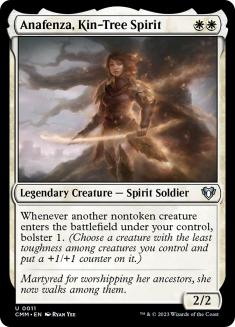
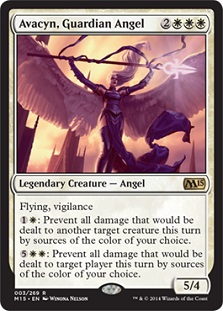
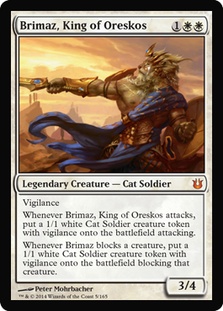
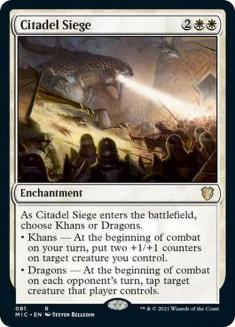
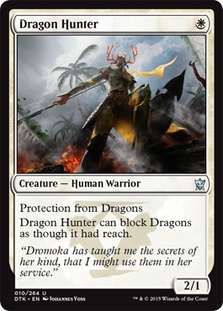
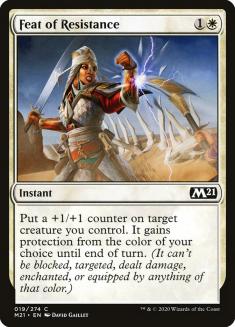
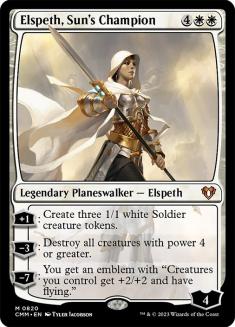
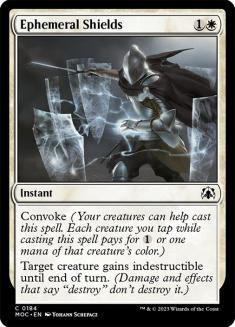
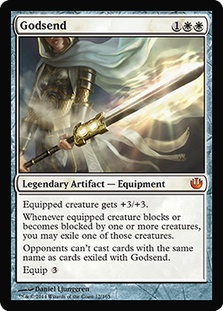
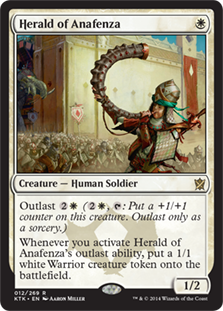
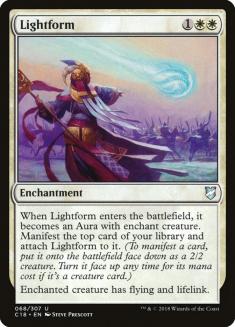
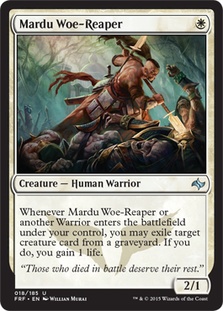
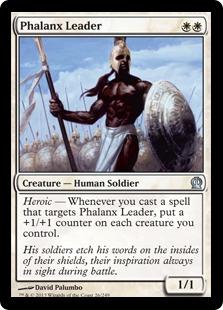
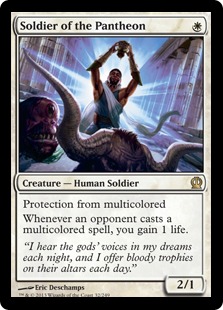
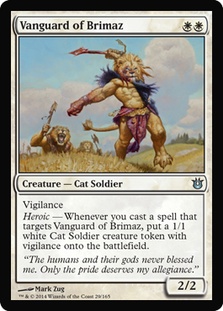

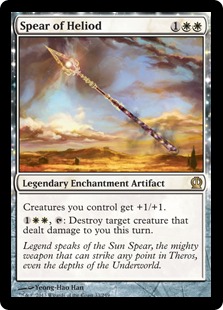
I notice, in looking at it, that there are actually a lot of great aggressive drops at one mana. Combined with Anafenza, this seems appealing – but I also know that these are going to be very small creatures. Dictate of Heliod wasn’t on my list, but I started to think about it because I’m thinking about what I’m going to do to keep my creatures relevant in a world with Siege Rhino and friends.
Banishing Light also comes to mind. It isn’t very efficient in terms of creating devotion, but it is a reasonable removal spell that will also help with the devotion count. Evangel of Heliod also comes to mind, since we’re going to be working on devotion and it is a potential incentive to playing devotion, but it feels a little too expensive unless you are going to be doing bizarre trickery with it.
Lightform seems particularly intriguing since it can actually do double duty on devotion if you flip up a creature. The beginning core of the deck is in my mind as a weenie deck, and I’m actually not really thinking of this as much of a Heliod deck after all.
Weenie decks, for example, generally haven’t used a token generation method that is as slow as Heliod. If Heliod were a card like Kjeldoran Outpost, it might make sense. If it were an incidental part of how the card worked, like, say, a white Dragon Whisperer, it might also make sense.
I still like the thought of a card like Dicate of Heliod, though, to pump things up, and I don’t mind Spear of Heliod and Godsend being a part of helping out. Once we have all of these cards already paying attention to devotion, maybe Nykthos could do something, but it won’t be as powerful as it would be in, say, a green devotion deck. Still, maybe it could pump up another spell, like Secure the Wastes.
Several drafts later, I have this deck:
Creatures (19)
- 1 Heliod, God of the Sun
- 4 Soldier of the Pantheon
- 2 Brimaz, King of Oreskos
- 4 Mardu Woe-Reaper
- 4 Anafenza, Kin-Tree Spirit
- 4 Dragon Hunter
Lands (23)
Spells (18)

Hmm. The whole idea of why I was working on this deck seems to have disappeared. There is a new aggressive white deck here, but it has a few elements that are working at odds with each other. I could test it now, but it doesn’t feel quite right, and it doesn’t look to me like any of the aggressive white decks I’ve seen that have succeeded.
Nothing jumps out.
Thinking about devotion, though, gets me thinking about this card:
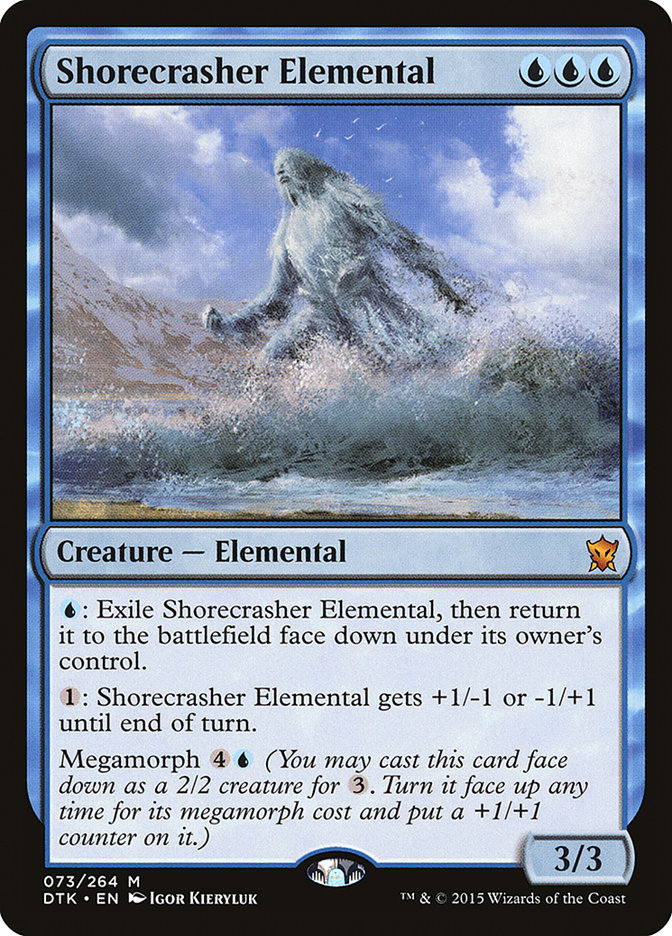
Maybe focusing on Shorecrasher Elemental will be more fruitful.
As far as incentives go, Thassa, God of the Sea is a known quantity, unlike Heliod, God of the Sun. We already know that Thassa is incredibly powerful, in part because the filtering ability of Thassa is powerful in its own right, plus the activated ability of Thassa is fairly cheap.
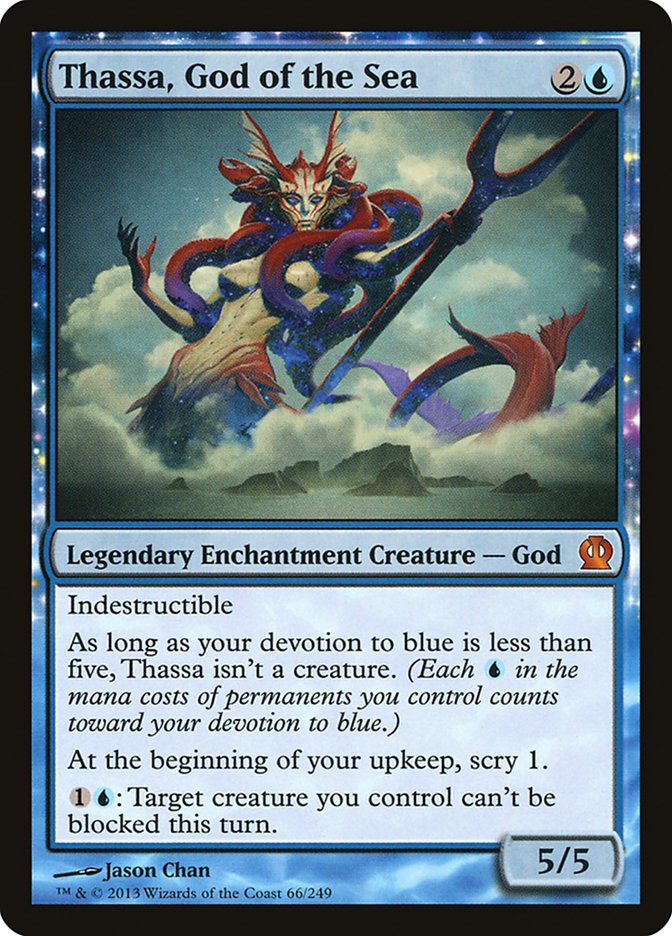
This seems like an incredibly good incentive.
Making a list of cards to brainstorm with, I come up with:
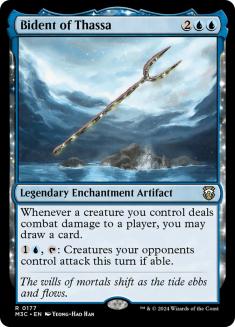

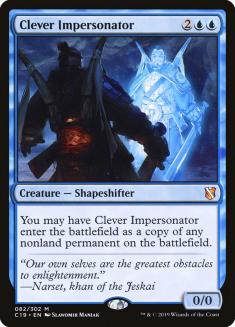
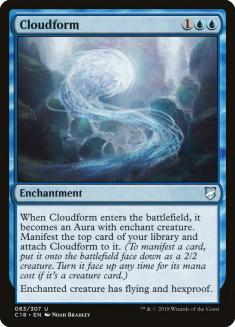
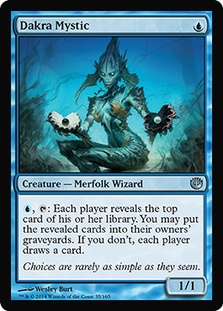
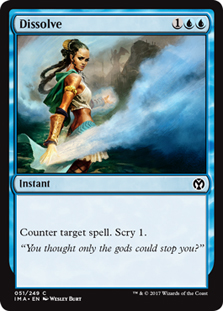
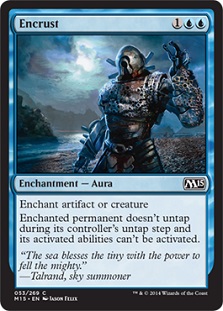
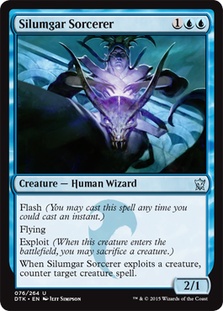
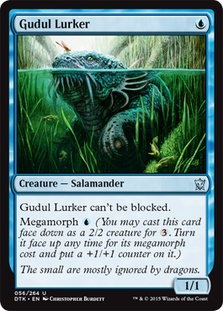
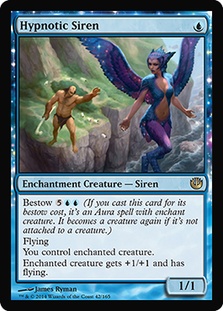
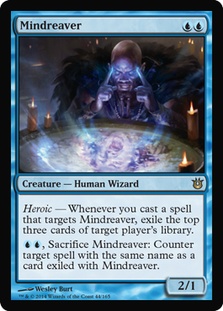
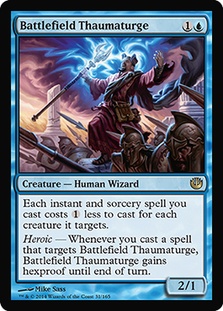
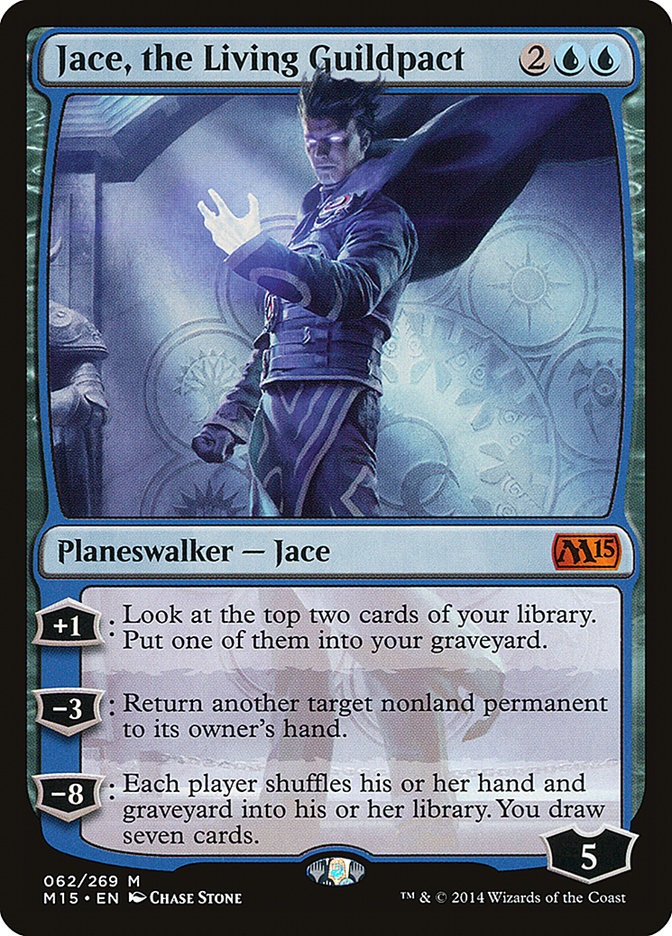
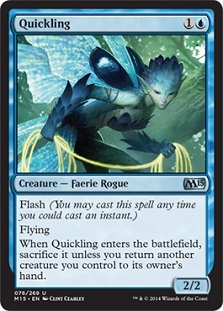
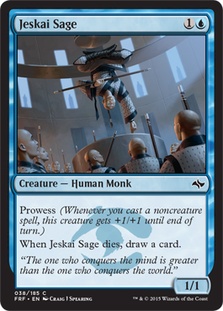
As I think about the idea, I see a lot of cards that I think can work together well. There isn’t a Frostburn Weird or a Cloudfin Raptor, so this deck can’t simply be a pure port from the past, but I do think there are some good elements here that can work together.
I take a quick trip to the past to my now-teammate Andrew Baeckstrom, who beat me in the finals of this PTQ with this deck:
Creatures (28)
- 4 Judge's Familiar
- 4 Frostburn Weird
- 4 Cloudfin Raptor
- 4 Nightveil Specter
- 4 Tidebinder Mage
- 4 Thassa, God of the Sea
- 4 Master of Waves
Planeswalkers (2)
Lands (24)
Spells (5)

I can see a lot to model myself after, here, and my first run goes something like this:
4 Gudul Lurker
4 Hypnotic Siren
4 Stratus Dancer
2 Bident of Thassa
4 Shorecrasher Elemental
4 Master of Waves
4 Thassa, God of the Sea
24 land
This leaves ten cards to fill.
Of course, there are some fundamental differences between what this deck can do and what that deck could do. I already have twelve morphs in this deck, so that might be something to consider. In addition, this might actually mean I should be looking for a little more mana.
There really aren’t a great amount of awesome two-mana spells, and that is a real problem. The old deck also had four powerful card advantage spells in the form of Jace, Architect of Thought and Bident of Thassa. I could go towards something like Military Intelligence, but I don’t know that I’ll get very much action out of that. Perhaps we could go with Treasure Cruise?
I end up with this as a draft:
Creatures (27)
- 4 Thassa, God of the Sea
- 4 Master of Waves
- 4 Hypnotic Siren
- 1 Triton Shorestalker
- 4 Stratus Dancer
- 4 Gudul Lurker
- 4 Shorecrasher Elemental
- 2 Silumgar Sorcerer
Lands (25)
Spells (8)

This actually looks like it could be the beginning of a deck. Putting it together, and pitting it up against a goldfish, it draws like it could be a deck as well.
I can tell by just looking on it that it will need work. That next step would be formally testing it. After that, it might end up needing to be revised from the ground up, or perhaps some other element would creep out. Maybe the aggro-control elements of the deck like Stratus Dancer and Simlugar Sorceror aren’t where the deck needs to be, and instead the deck should be some kind of Master of the Waves, Mirror Mockery craziness, with four Hall of Triumph to make it work perfectly.
Where this deck might go next and how good it might be is anyone’s guess. My instincts say there is something down this path, but the end result might not be that great. The only way to find out, though, is to test it out and see.


